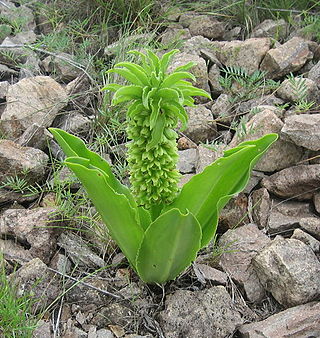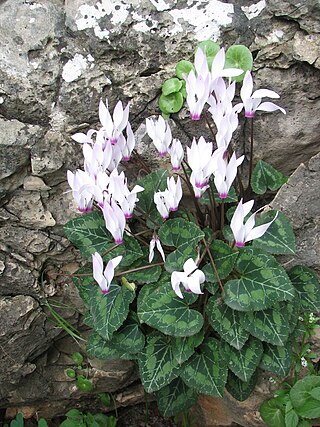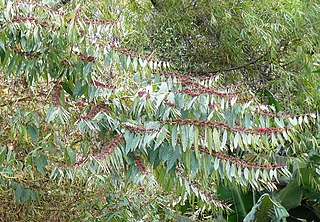
Amaryllis is the only genus in the subtribe Amaryllidinae. It is a small genus of flowering bulbs, with two species. The better known of the two, Amaryllis belladonna, is a native of the Western Cape region of South Africa, particularly the rocky southwest area between the Olifants River Valley and Knysna.

Forsythia, is a genus of flowering plants in the olive family Oleaceae. There are about 11 species, mostly native to eastern Asia, but one native to southeastern Europe. Forsythia – also one of the plant's common names – is named after William Forsyth.

Freesia is a genus of herbaceous perennial flowering plants in the family Iridaceae, first described as a genus in 1866 by Christian Friedrich Ecklon (1886) and named after the German botanist and medical practitioner, Friedrich Freese (1795-1876). It is native to the eastern side of southern Africa, from Kenya south to South Africa, most species being found in Cape Provinces. Species of the former genus Anomatheca are now included in Freesia. The plants commonly known as "freesias", with fragrant funnel-shaped flowers, are cultivated hybrids of a number of Freesia species. Some other species are also grown as ornamental plants.

Osteospermum, is a genus of flowering plants belonging to the Calenduleae, one of the smaller tribes of the sunflower/daisy family Asteraceae. They are known as the daisybushes or African daisies. Its species have been given several common names, including African daisy, South African daisy, Cape daisy and blue-eyed daisy.

Digitalis purpurea, the foxglove or common foxglove, is a toxic species of flowering plant in the plantain family Plantaginaceae, native to and widespread throughout most of temperate Europe. It has also naturalised in parts of North America and some other temperate regions. The plant is a popular garden subject, with many cultivars available. It is the original source of the heart medicine digoxin. This biennial plant grows as a rosette of leaves in the first year after sowing, before flowering and then dying in the second year. It generally produces enough seeds, however, so that new plants will continue to grow in a garden setting.

Chlorophytum comosum, usually called spider plant or common spider plant due to its spider-like look, also known as spider ivy, ribbon plant, and hen and chickens is a species of evergreen perennial flowering plant of the family Asparagaceae. It is native to tropical and Southern Africa but has become naturalized in other parts of the world, including Western Australia and Bangladesh. Chlorophytum comosum is easy to grow as a houseplant because of its resilience, but it can be sensitive to the fluoride in tap water, which commonly gives it "burnt tips". Variegated forms are the most popular.

Clivia miniata, the Natal lily or bush lily, is a species of flowering plant in the genus Clivia of the family Amaryllidaceae, native to woodland habitats in South Africa as well as in Eswatini. Given suitable conditions it grows into large clumps and is surprisingly water wise. It is also reportedly naturalized in Mexico. It is a popular plant for shady areas and is commonly seen growing in older established suburbs in most Australian states. It is also popular in New Zealand, Japan, China and the US, particularly California.

Weigela is a genus of between six and 38 species of deciduous shrubs in the family Caprifoliaceae, growing to 1–5 m (3–15′) tall. All are natives of eastern Asia. The genus is named after the German scientist Christian Ehrenfried Weigel.

Albuca bracteata, is known by the common names pregnant onion, false sea onion, and sea-onion. It is a species of bulbous flowering plant in the family Asparagaceae. Its flowering stems can reach a height of 90 cm and can carry up to 100 greenish white flowers.

Eucomis autumnalis, the autumn pineapple flower, or autumn pineapple lily, is a species of flowering plant in the family Asparagaceae, subfamily Scilloideae, native to Malawi, Zimbabwe and southern Africa. It is a mid to late summer flowering deciduous bulbous perennial. The flower stem reaches about 40 cm (16 in), rising from a basal rosette of wavy-edged leaves. The green, yellow or white flowers are arranged in a spike (raceme), topped by a "head" of green leaflike bracts. It is grown as an ornamental garden plant and can also be used as a cut flower.

Cladoraphis is a genus of African plants in the grass family, native to southern Africa. Its phylogenetic position within the subfamily has not yet been resolved.

Sarcococca confusa, the sweet box, is a species of flowering plant in the family Buxaceae, probably native to western China. It is an evergreen shrub growing to 2 m (7 ft) tall by 1 m (3 ft) broad, with glossy green ovate leaves and honey-scented white flowers in winter, followed by glossy black spherical fruits, 5 mm in diameter.

Cyclamen persicum, the Persian cyclamen, is a species of flowering herbaceous perennial plant growing from a tuber, native to rocky hillsides, shrubland, and woodland up to 1,200 m (3,900 ft) above sea level, from south-central Turkey to Lebanon-Syria and the Palestine region. It also grows in Algeria and Tunisia and on the Greek islands of Rhodes, Karpathos, and Crete, where it may have been introduced by monks. Cultivars of this species are the commonly seen florist's cyclamen.
Walteranthus is a monotypic genus of flowering plants belonging to the family Gyrostemonaceae. It only contains one known species, Walteranthus erectus.
Holubia is a monotypic genus of flowering plants belonging to the family Pedaliaceae. The only species is Holubia saccata.

Hewittia malabarica is a flowering plant in the monotypic genus HewittiaWight & Arn., belonging to the family Convolvulaceae and widespread throughout tropical Africa, Asia, and Polynesia. It is a climbing or prostrate perennial herb with slender stems and flowers that are pale yellow, cream, or white with a purple center, and large leaves that can be used as a cooked vegetable or used in folk medicine with the roots. The stems can be used to make ropes.
Goethalsia is a monotypic genus of flowering plants belonging to the family Malvaceae. It only contains one species, Goethalsia meiantha(Donn.Sm.) Burret It is within the Grewioideae tribe.

Pehria is a monotypic genus of plant in family Lythraceae. It has one known synonym, GrisleaLoefl.. The genus just contains one known species, Pehria compacta(Rusby) Sprague

Paranomus sceptrum-gustavianus, the King Gustav's sceptre, is a flowering shrub that belongs to the genus Paranomus and forms part of the fynbos. The plant is native to the Western Cape, South Africa.

Exomis is a genus of flowering plants belonging to the family Amaranthaceae. It just contains one species, Exomis microphylla(Thunb.) Aellen It is also in the Chenopodioideae subfamily.


















